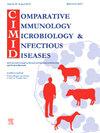Zoonotic variants of Bartonella henselae in domesticated cats, including blood donors, in central-western Brazil
IF 2
3区 农林科学
Q4 IMMUNOLOGY
Comparative Immunology Microbiology and Infectious Diseases
Pub Date : 2025-08-19
DOI:10.1016/j.cimid.2025.102398
引用次数: 0
Abstract
Bartonella henselae is a significant zoonotic agent, with domestic cats serving as primary reservoirs. This study investigated the occurrence and genetic diversity of B. henselae in domestic cats from central-western Brazil, including both animals from veterinary clinics and cat blood donors. Serological, microbiological, and molecular techniques were employed. Serum samples were tested using the Indirect Fluorescence Antibody Test (IFAT) to detect anti-B. henselae IgG antibodies. Molecular detection of Bartonella spp. was performed using quantitative real-time PCR (qPCR) targeting the 16–23S rRNA intergenic spacer region, both directly from blood and after enrichment in Bartonella Alpha Proteobacteria Growth Medium (BAPGM). Antibodies were detected in 60.75 % of cats, while qPCR identified Bartonella spp. DNA in 32 % and 46 % of cats from veterinary clinics and blood donors, respectively. Following BAPGM enrichment, 78.2 % of previously negative samples were tested positive by qPCR. Co-positivity in serology and qPCR was observed in 25.3 % of cats. No sample tested positive in all diagnostic methods. Three B. henselae strains were isolated—two from clinic cats and one from a blood donor. Multi-locus sequence typing (MLST) revealed the presence of sequence types ST1, ST2, and ST5. This study is the first to report Bartonella in cat blood donors in South America and the first identification of ST5 in this population. Additionally, ST2 was reported for the first time in cats from the Americas. These findings highlight the potential risk of zoonotic B. henselae transmission via blood transfusion and the limited reliability of serology alone for screening blood donor cats.
巴西中西部家养猫(包括献血者)中亨塞拉巴尔通体的人畜共患变异
亨塞拉巴尔通体是一种重要的人畜共患病原体,家猫是主要的宿主。本研究调查了巴西中西部家猫(包括来自兽医诊所和献血者的猫)中亨selae b的发生和遗传多样性。采用血清学、微生物学和分子技术。血清样品采用间接荧光抗体试验(IFAT)检测抗- b。母鸡IgG抗体。采用实时荧光定量PCR (qPCR)技术检测巴尔通体(Bartonella Alpha Proteobacteria Growth Medium, BAPGM)的16-23S rRNA基因间隔区。在60.75 %的猫中检测到抗体,而在兽医诊所和献血者的猫中分别检测到32% %和46% %的巴尔通体DNA。在BAPGM富集后,78.2% 先前阴性的样品通过qPCR检测为阳性。25.3 %的猫血清和qPCR同时呈阳性。所有诊断方法均未发现阳性样本。分离出三株B. henselae菌株——两株来自门诊猫,一株来自献血者。多位点序列分型(MLST)显示存在ST1、ST2和ST5序列类型。本研究首次报道了南美洲猫献血者中巴尔通体的存在,并首次在该人群中发现了ST5。此外,首次在美洲的猫中报告了ST2。这些发现强调了通过输血传播人畜共患病亨selae的潜在风险,以及单独使用血清学筛查献血猫的有限可靠性。
本文章由计算机程序翻译,如有差异,请以英文原文为准。
求助全文
约1分钟内获得全文
求助全文
来源期刊
CiteScore
4.60
自引率
0.00%
发文量
102
审稿时长
40 days
期刊介绍:
Comparative Immunology, Microbiology & Infectious Diseases aims to respond to the concept of "One Medicine" and to provide a venue for scientific exchange. Based on the concept of "Comparative Medicine" interdisciplinary cooperation between specialists in human and animal medicine is of mutual interest and benefit. Therefore, there is need to combine the respective interest of physicians, veterinarians and other health professionals for comparative studies relevant to either human or animal medicine .
The journal is open to subjects of common interest related to the immunology, immunopathology, microbiology, parasitology and epidemiology of human and animal infectious diseases, especially zoonotic infections, and animal models of human infectious diseases. The role of environmental factors in disease emergence is emphasized. CIMID is mainly focusing on applied veterinary and human medicine rather than on fundamental experimental research.

 求助内容:
求助内容: 应助结果提醒方式:
应助结果提醒方式:


